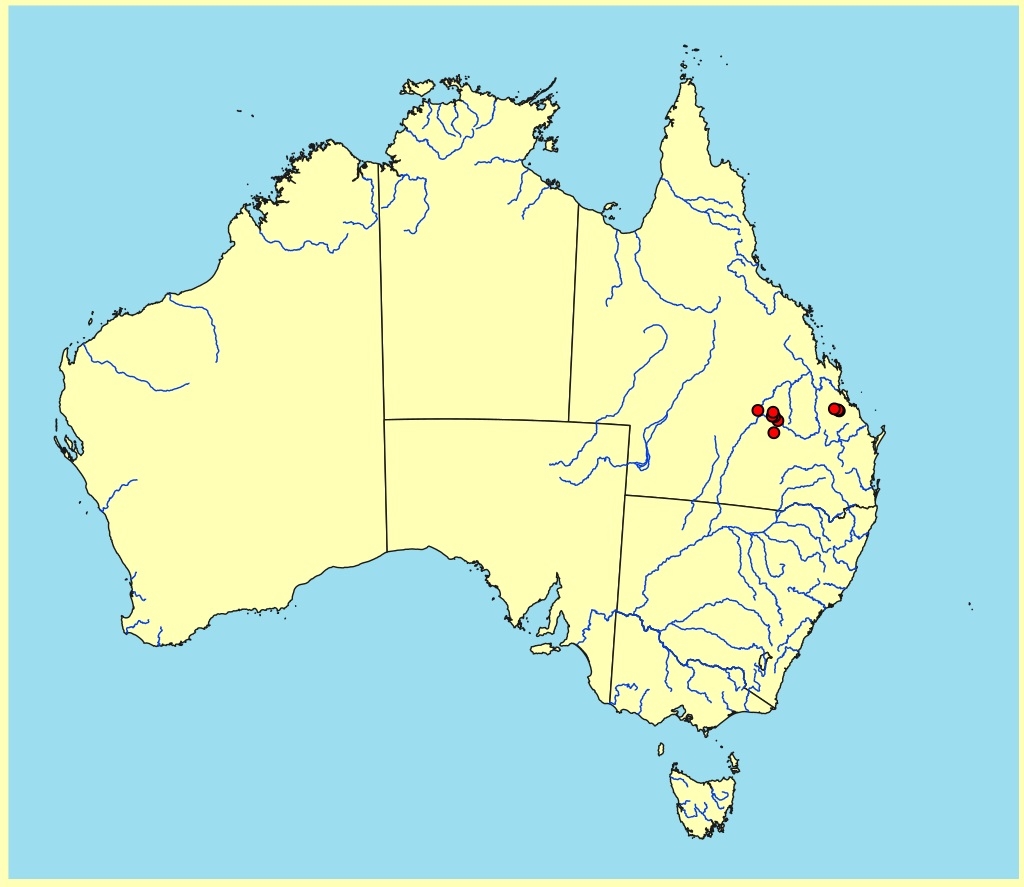Eucalyptus | Eucalyptus | Capillulus | Pachyphloius
Euclid - Online edition
Eucalyptus erosa
Tree to 30 m tall. Forming a lignotuber.
Bark rough to small branches, stringy, grey or grey-brown.
Juvenile growth (coppice or field seedlings to 50 cm): stem rounded in cross-section, stellate hairy becoming rough to touch (scabrid); juvenile leaves shortly petiolate (petioles 0.2–0.8 cm), sub-opposite to alternate, leaves usually ovate or sometimes shortly lanceolate, 3.5–7.5 cm long, (1.3)2–3 cm wide (l:w ratio range 1.8 to 2.6), margin shallowly denticulate, base rounded to tapering or oblique, apex pointed, discolorous, glossy green above; scabrid on stems, petioles, leaf margin and midrib on underside for a few to many nodes. The denticulate leaf margin due to presence of developing "lenticels".
Adult leaves alternate, petiole 0.8–1.7 cm long; blade lanceolate to falcate, 7–14 cm long, 1.1–2.8 cm wide, base usually oblique or occasionally tapering, concolorous (but may dry discolorous), glossy green, side-veins acute, reticulation sparse, intramarginal vein present, oil glands island.
Inflorescence axillary unbranched, peduncles 0.7–1.4 cm long, buds in umbels of 9, 11 or 13, pedicels 0.2–0.5 cm long. Mature buds ovoid to obovoid, 0.6–0.8 cm long, 0.3–0.4 cm wide, smooth, scar absent, operculum conical or apiculate about half the length of the bud, outer stamens irregularly flexed and inner stamens inflexed, anthers reniform to cordate, versatile, dorsifixed, dehiscing by confluent slits, style long, stigma blunt to tapered, locules 3 or 4, the placentae each with 2 vertical ovule rows. Flowers white.
Fruit on pedicels 0.2–0.5 cm, hemispherical, 0.4–0.6 cm long, 0.6–0.8 cm wide, disc level, valves 3 or 4, near rim level.
Seeds blackish or dark brown, 1.5–2 mm long, pyramidal or obliquely pyramidal, dorsal surface smooth, hilum terminal.
Cultivated seedlings (measured at ca node 10): cotyledons reniform; stems rounded in cross-section, densely stellate-hairy; leaves shortly petiolate, usually opposite or becoming sub-opposite, ovate to lanceolate, 5.5–8 cm long, 1.3–3.3 cm wide, base rounded or tapering, margin minutely denticulate (pustulate due to developing lenticels), apex pointed, discolorous, green and glossy above, paler beneath. Stems and leaves prominently scabrid with stellate hairs for 10+ nodes.
Flowering has been recorded in May and July.
A stringybark tree of tall straight form endemic to Queensland where found in higher parts of the eastern and central Carnarvon Range and disjunctly in the Kroombit Tops area. It occurs on undulating sites with coarse sandy soils. The crown is green and glossy with the adult leaves bearing "lenticels" distantly placed along the leaf margin giving a shallowly notched appearance, buds occur in clusters of 9 to 13, and fruits are hemispherical with valves held at rim level; juvenile (coppice) growth is scabrid with shortly petiolate ovate to lanceolate leaves.
Eucalyptus erosa had previously been included in E. eugenioides but is now regarded as a distinct species. It is distinguished from other stringybark species by the lenticel-like structures on the adult leaf margin. Other stringybark species also showing "lenticels" are: E. expressa from north-east of Sydney and E. mckieana from the tablelands and nearby western slopes between Armidale New South Wales and Stanthorpe in Queensland. E. eugenioides, a species predominately from the coastal ranges of New South Wales, usually lacks these "lenticels" but is otherwise similar to E. erosa. E. mckieana has distinctive linear to lanceolate juvenile leaves (coppice). E. expressa has small fruit with prominently exserted valves and ovate juvenile leaves.
Eucalyptus erosa: from the Latin erosus meaning eroded, a reference to the distantly denticulate (notched, eroded) leaf margin.






